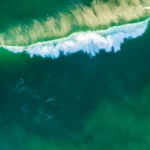If you have ever looked at a sea lion, you would know how big they really are – huge mammals with opalescent eyes and its long canine teeth hinting at its evolutionary connection with terrestrial predators like dogs and bears.
Most of the mammals tend to grow really big when they invade the ocean. From pinnipeds to manatees and dugongs, all are very big. Have you ever wondered, though, why mammals like whales who live in ocean get so surprisingly huge and intimidating?
Most of the explanations for this trend treat the ocean as a kind of release. The water partly frees mammalian bodies from the yoke of gravity, allowing them to evolve heavy bodies that they couldn’t possibly support on land. The water unshackles them from the constraints of territory, giving them massive areas over which to forage. The water liberates them from the slim pickings of a land-based diet and offers them vast swarms of plankton, crustaceans, and fish to gorge upon.
But William Gearty from Stanford University has a very different explanation. To him, the ocean makes mammals big not because it relieves them off-limits, but because it imposes new ones.
“As you enter the water, you start to lose heat from your body that you aren’t losing on land or air,” he explains. To counteract that constant loss of heat, humans use wet suits, whales have blubber, and otters have thick fur. “But really the easiest way to counteract it is to get bigger,” Gearty says. As bodies balloon, volume increases faster than surface area does, so you produce more heat in your body but lose comparatively less of it from your skin. But animals can’t become infinitely big because larger bodies also demand more fuel. There’s only so much food that an animal can reasonably find, catch, and swallow.
So, the need to stay warm sets a floor for the body size of oceanic mammals, while the need to eat sets a ceiling. And the gap between them, Gearty found, is surprisingly narrow—and far more so than on land.
Together with Jonathan Payne, also from Stanford, and Craig McClain from the Louisiana Universities Marine Consortium, Gearty collected data on the sizes of almost 7,000 mammal species, both living and extinct. He showed that the marine groups—whales, manatees, and seals—have all independently hit an average optimum mass of around 1,100 pounds.
There’s obviously a lot of variation around that—a sperm whale is clearly not the same size as a dolphin. But crucially, that variation is much lower in the sea than it is on land. “The minimum size in these aquatic groups is thousands of times larger than the minimum for terrestrial groups, but the maximum size is only 25 times larger,” says Gearty. “I found it strange that no one had noticed before.”
These trends aren’t consistent with the idea of the ocean as a release. Instead, it suggests that the water imposes strict constraints. To thrive in it, mammals must be just the right size—big, yes, but not too big and not too small. And Gearty could calculate the boundaries of this Goldilocks zone with a set of equations that connect a mammal’s size with the heat it loses to the water and the rate at which it can find food. These equations predicted both the optimum 1,100-pound average that seagoing mammals have evolved toward and the narrow range of sizes around that ideal.
And as always in biology, there are exceptions. Sea otters, for example, are unusually small for marine mammals—they’re about as big as a Labrador. That might be because their extremely thick fur, with up to a million hairs per square inch, allows them to stay warm without being big. They also spend a lot of time on land, where heat loss is less of a problem.







